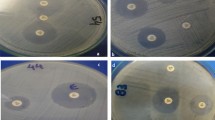Abstract
Minimal inhibitory concentrations (MICs) of five antibiotics namely amikacin, gentamicin, tetracycline, ciprofloxacin, and nitrofurantoin for pork isolates of Yersinia enterocolitica increased two- to eightfold after bacteria were grown in the presence of 5 mm arsenite. For Y. enterocolitica isolates obtained from wastewater (sewage effluents), an unequivocal increase in MICs was seen with amikacin and gentamicin. No change was discernible in the outer-membrane proteins after isolates were grown in the presence of arsenite.
Similar content being viewed by others
Author information
Authors and Affiliations
Additional information
Received: 14 October 2000 / Accepted: 26 January 2001
Rights and permissions
About this article
Cite this article
Virdi, J., Sinha, I., Rajendran, P. et al. Arsenite-Induced Multiple Antibiotic Resistance Phenotype in Environmental Isolates of Yersinia enterocolitica . Curr Microbiol 43, 144–146 (2001). https://doi.org/10.1007/s002840010277
Issue Date:
DOI: https://doi.org/10.1007/s002840010277




